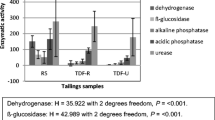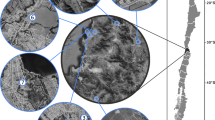Abstract
Earthworm mesocosms studies were carried out on a explosives-contaminated site at an antitank firing range. Survival of earthworms and the lysosomal neutral red retention time (NRRT), a biomarker of lysosomal membrane stability, were used in these studies to assess the effect of explosives-contaminated soils on the earthworms Lumbricus terrestris and Eisenia andrei under field conditions. Toxicity of the soils samples for E. andrei was also assessed under laboratory conditions using the earthworms reproduction test and the NRRT. Results indicate that the survival was reduced up to 40% in certain explosive-contaminated soil mesocosms following 10 days of exposure under field conditions, whereas survival was reduced up to 100% following 28 days of exposure under laboratory conditions. Reproduction parameters such as number of cocoons and number of juveniles were reduced in many of the selected contaminated soils. Compared to the reference, NRRT was significantly reduced for E. andrei exposed to explosive-contaminated soils under both field and laboratory conditions, whereas for L. terrestris NRRT was similar compared to the reference mesocosm. Analyses showed that HMX was the major polynitro-organic compound in soils. HMX was also the only explosive detected in earthworm tissues. Thus, results from both field mesocosms and laboratory studies, showed lethal and sub-lethal effects associated to soil from the contaminated area of the antitank firing range.
Similar content being viewed by others
References
Booth, L.H., Heppelthwaite, V.J., Webster, R. and O'Halloran, K. (2001). Lysosomal neutral red retention time as a biomarker of organophosphate exposure in the earthworm Aporrectodea caliginosa: laboratory and semi-field experiments. Biomarkers 6, 77–82.
Goven, A.J., Eyambe, G.S., Fitzpatrick, L.C., Venables, B.J. and Cooper, E.L. (1993). Cellular biomarkers for measuring toxicity of xenobiotics: effects of polychlorinated biphenyls on earthworm Lumbricus terrestris coelomocytes. Environ. Toxicol. Chem. 12, 863–70.
Goven, A. J., Chen, S.C., Fitzpatrick, L.C. and Venables, B. J. (1994). Lysosyme activity in the earthworm (Lumbricus terrestris) coelomomic fluid coelomocytes: enzyme assay for the immunotoxicity of xenobiotics. Environ. Toxicol. Chem. 13, 607–13.
Harreus, D., Köhler, H.-R. and Weeks, J.M. (1997). Combined non-invasive cell isolation and neutral-red retention assay for measuring the effect of copper on the Lumbricid Aporrectodea rosea (Savigny). Bul. Environ. Contam. Toxicol. 59, 44–9.
ISO. (1994). Soil Quality-Determination of pH. ISO 103390. Geneva: International Organization for Standardization.
ISO. (1998) Soil Quality-Effects of Soil Pollutants on Earthworms (Eisenia fetida). Part 2: Determination of Effects on Reproduction. ISO 11268-2.2. Geneva: International Organization for Standardization.
OECD. (1984). Earthworm, acute toxicity tests. In Guideline of the OECD for Testing Chemical Products, Paris: Organization for European Cooperation and Development.
Renoux A.Y., Sarrazin M., Hawari J. and Sunahara G.I. (2000). Transformation of 2,4,6-trinitrotoluene (TNT) in soil in the presence of the earthworm Eisenia andrei. Environ. Toxicol. Chem. 19, 1473–80.
Robidoux, P.Y., Svendsen, C., Caumartin, J., Hawari, J., Ampleman, G., Thiboutot, S., Weeks, J.M. and Sunahara, G.I. (2000). Chronic toxicity of energetic compounds in soil determined using the earthworm (Eiseinia andrei) reproduction test. Environ. Toxicol. Chem. 19, 1764–73.
Robidoux, P.Y., Hawari, J., Thiboutot, S. and Sunahara, G.I. (2001). Chronic toxicity of octahydro-1,3,5,7-tetranitro-1,3,5,7-tetrazocine (HMX) in soil using the earthworm (Eisenia andrei) reproduction test. Environ. Poll. 111, 283–92.
Robidoux, P.Y., Hawari, J., Bardai, G., Ampleman, G., Thiboutot, S. and Sunahara, G.I. (2002a). TNT, RDX and HMX decrease earthworm (Eisenia andrei) life-cycle responses in a spiked natural forest soil. Arch. Environ. Contam. Toxicol. 43, 379–88.
Robidoux, P.Y., Svendsen, C., Sarrazin, M., Hawari, J., Thiboutot, S., Ampleman, G., Weeks, J.M. and Sunahara, G.I. (2002b). Evaluation of tissue and cellular biomarkers to assess 2,4,6-trinitrotoluene (TNT) exposure in earthworms: effects-based assessment in laboratory studies using Eisenia andrei. Biomarkers 7, 306–21.
Robidoux, P.Y., Gong, P., Sarrazin, M., Bardai, G., Paquet, L., Hawari, J., Dubois, C. and Sunahara, G.I. Toxicity assessment of contaminated soils from an antitank firing range. Ecotoxicol Environ. Saf. (in press).
Scott-Fordsmand, J.J., Weeks, J.M. and Hopkin, S.P. (1998). Toxicity of nickel to the earthworm and the applicability of the neutral red retention time. Ecotoxicology 7, 291–5.
Spurgeon, D.J., Svendsen, C., Rimmer, V.R. Hopkin, S.P. and Weeks, J.M. (2000). Relative sensitivity of life-cycle and biomarker responses in four earthworm species exposed to zinc. Environ. Toxicol. Chem. 19, 1800–8.
Svendsen, C. and Weeks, J.M. (1997a). Relevance and applicability of a simple earthworm biomarker of copper exposure; I. Links to ecological effects in a laboratory study with Eisenia andrei. Ecotoxicol. Environ. Safe. 36, 72–9.
Svendsen, C. and Weeks, J.M. (1997b). Relevance and applicability of a simple earthworm biomarker of copper exposure; II. Validation and applicability under field conditions in a mesocosm experiment with Lumbricus rubellus. Ecotoxicol. Environ. Safe. 36, 80–8.
Svendsen, C., Meharg, AA., Freestone, P. and Weeks, J.M. (1996). Use of an earthworm lysosomal biomarker for the ecological assessment of pollution from an industrial plastics fire. Appl. Soil Ecol. 3, 99–107.
Thiboutot, S., Ampleman, G., Gagnon, A., Jenkins, T.F., Walsh, M.E., Thorne, P.G. and Ranney, T.A. (1998). Characterization of Antitank Firing Ranges at CFB Valcartier, WATC Wainwright and CFAD Dundurn. Defence Research Establishment Valcartier, Research and Development Branch, Department of National Defence Canada. DREV-R-9809. p. 54.
USEPA. (1997). Method 8330: Nitroaromatics and nitramines by high performance liquid chromatography (HPLC). In Test Methods for Evaluating Solid Waste. SW-846, update III; part 4:1 (B). Washington, DC: United States Environmental Protection Agency, Office of Solid Waste.
Weeks, J.M. and Svendsen, C. (1996). Neutral red retention by lysosomes from earthworm (Lumbricus rubellus) coelomocytes: a simple biomarker of exposure to soil copper. Environ. Toxicol. Chem. 15, 1801–5.
Author information
Authors and Affiliations
Rights and permissions
About this article
Cite this article
Yves Robidoux, P., Dubois, C., Hawari, J. et al. Assessment of Soil Toxicity from an Antitank Firing Range Using Lumbricus terrestris and Eisenia andrei in Mesocosms and Laboratory Studies. Ecotoxicology 13, 603–614 (2004). https://doi.org/10.1023/B:ECTX.0000037195.69892.35
Issue Date:
DOI: https://doi.org/10.1023/B:ECTX.0000037195.69892.35




